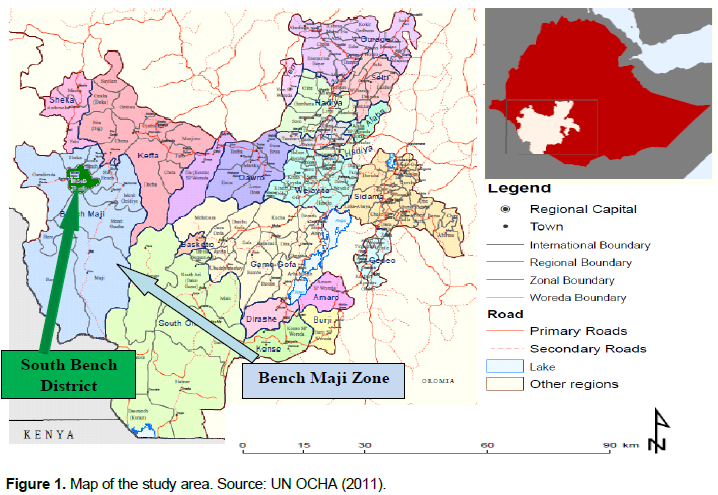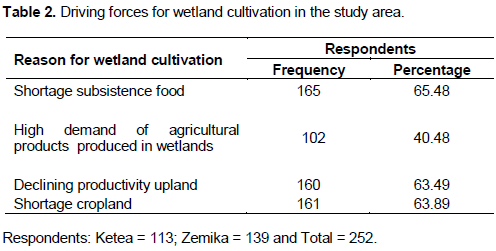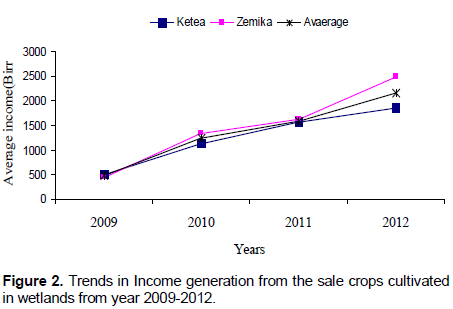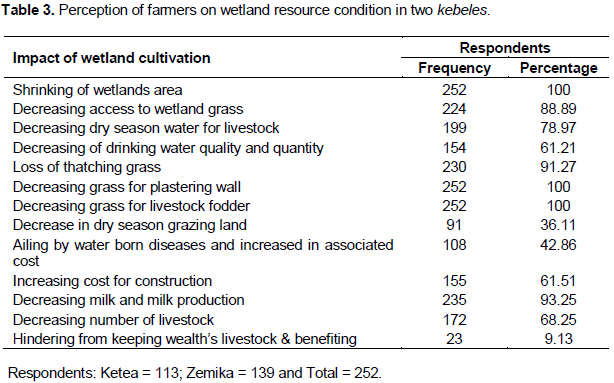The global wetland area is generally estimated to be 4 to 6% of the land surface of the earth (7 to 9 million km2) (Mitsch and Gosselink, 2000). Wetlands are among the most biologically productive ecosystems as they are rich in species diversity and habitats (Mironga, 2005; Mwakaje, 2009). Wetlands support millions of people, not only to the local population living in their periphery but also to the national, regional as well as global outside the wetland (Ramachandra et al., 2011; Roy et al., 2012; Hagos et al., 2014). According to assessment of Costanza et al. (1997), the dollar value of wetlands worldwide was estimated to be $14.9 trillion. However, this important resource is so fragile and has suffered deterioration due to human activities such as cultivation, grazing, urbanizations and industrializations, water abstraction among others (Wuver and Attuquayefio, 2006; Crecious and Lazarus, 2013; Hagos et al., 2014). Besides, Sakataka and Namisiko (2014) also reported that wetland encroachment and subsequent degradation is caused by land hunger due to fast rising population. Moreover, Musamba et al. (2011) indicated that the wetland was found to be decreasing in size every year due to various socio-economic activities.
It is difficult to say much information about wetland ecosystem in developing country like Ethiopia due to limited studies of cause, consequence and remedial of wetland degradation. However, some studies (e.g. Abunje, 2003; Ayalew, 2010) estimated that Ethiopian wetlands cover an area of 13,699 km2 area, or roughly 2% of the country’s land surface. According to Dixon and Wood (2003) report, wetlands are becoming increasingly important and recognized as vital natural resources because wetlands have wide range of environmental functions and produce multiple products that are socially and economically beneficial to local communities of Ethiopia. But, there was high degradation of wetlands due to increasing demand of wetland cultivation (Legesse, 2007; Mellese, 2008). Cultivation of wetlands has existed in highland of Ethiopia for at least eight decades (Dixon and Wood, 2003; Mulugeta, 2004), with an average cultivation of 23% of the total wetland area (Mulugeta, 2004). Wetlands are ranked amongst the most highly threatened ecosystems in Ethiopia and unfortunately the degradation and loss of wetlands are continuing (Hagos et al., 2014).
Drainage and soil improvement mostly involved with wetlands cultivation have often totally destroyed their ecological character and the ecosystem services that go with it (Afework et al., 2005; Verhoeven and Setter, 2010). Disturbance to wetlands especially from agricultural activity is often considered as causes for degradation of wetland hydrology (Dixon, 2002), and elimination of native species and introduction of weedy species (Zedler and Kercher, 2004; Handa et al., 2012; Kassahun et al., 2014) which generally reduces the value of ecological and socio-economical of the wetland for wetland dependent species (Collins, 2005). Moreover, degradation and losses of wetlands linked to drainage causes the losses of the resources collected from the wetlands, increase the scarcity of thatching reeds, change in water quantity and quality, decrease in crop and livestock production, and loss of biodiversity which directly and indirectly affects the livelihoods of communities (Afework, 2003; Legesse, 2005, 2007).
In southwestern Ethiopia, the effect of considerable conversion of wetlands to cultivated land is received with little attention by decision maker and community. For such problems, research based information is vital to enhance awareness of the stakeholder on wetland management and for designing strategies and implementation of sustainable utilization of wetland resources. Although, the research on consequence of change of wetland to agricultural land on soil physicochemical and plant biodiversity of this area was recently conducted by Kassahun et al. (2014) shows that the degradation of soil fertility and loss of ecological valuable plant species. However, scientific information of the effect of human induced wetland deterioration on socio-economic is not available. Therefore, the objective of this study was to identify the socio-economic impacts of wetland cultivation.
Descriptions of the study site
The study area is located in southwest of Ethiopia and nearly 586 km away from Addis Ababa, the Federal Capital of Ethiopia (Figure 1). The geographic location of the study area is between 29°23' 13.401" and 29°41' 37.004" east latitude and between 6°43' 55.916" and 6°59' 42.775" north longitude. The area receives annual rainfall of nearly 1,000 to 1,452 mm and much of it falls during March - November. The mean annual minimum and maximum temperature is 18 and 25°C, respectively. The altitudes range from 1,000 to 2,200 m above sea level with undulating plains and mountains.

The study conducted in two kebeles (peasant associations) selected purposively among 25 kebeles was based on the relative extent of wetland coverage and wetland use. Households were the basic sampling unit for individual interviews. Households were selected using systematic random sampling technique and the numbers of sample size from each kebele was proportion to total households of each kebeles. The formula of Krejcie and Morgan (1970) was used to determine a sample size of 252 (Zemika = 139 and Ketea = 113) from the total of 734 (Zemika = 405 and Ketea = 329) household heads.
Where: s = required sample size; x2 = the table value of chi-square for 1 degree of freedom at the desired confidence level (3.841); N = the population size; P = the population proportion (assumed to be P = 0.50 since this would provide the maximum sample size); d = the degree of accuracy expressed as a proportion (0.05).
Semi-structured questionnaires were used for household interviews and focus group discussions (FGD). FGD was conducted with two groups of farmers and a total of 17 farmers from each kebeles. This was done to secure additional information on the extent and trends of wetland cultivation and its impact. The questionnaire consisted of a wide range of issues such as household characteristics, wetland resource use, and access to wetland resources, wetland cultivation, and wetland resource degradation and its consequences. The formal survey was conducted by trained enumerators who have knowledge about the study areas and speak and write the local language.
Data analysis
Qualitative responses were summarized, categorized and coded into numeric values. The data was summarized using Statistical package for social science, version 16.0 (SPSS). Descriptive statistics, charts, frequencies tables and graphs were used to present the results. The data obtained from FGD and field observation were written in the form verbal/narrative information.
Household’s characteristics
The result of household characteristics indicated that 37.7% of the households had a family size of 4 to 6, 28.2% had 7 to 9, 20.6% had more than or equal to 10 and 15.5% had 1 to 3. The sex composition of the sampled households head showed that 94.8% of them were male and 5.2% of them were female. Among the households, 99.2% of them were married and 0.8% was unmarried. The age structure of household heads indicated that the majority of the household heads (52%) were in the age group of 26 to 35 years, followed by 36 to 45 years (29.37%), 16 to 25 years (8.73%), and then 46 to 55 years (3.17%). Education background of 74.6, 10.7, 9.9 and 4.8% of the households were primary education, illiterate, adult literacy and secondary school, respectively. The landholding size of 59.52% of the respondents had ³ 1 ha, 22.22% had 0.6 t 1.0 ha, 11.11% had 0.26 to 0.50 ha and 7.14% had £ 0.25 ha. Notable amount of households (40.48%) hand less than 1 ha and hence, this was an indicator of shortage of cropland that drives the farmers to change wetland into agricultural land.
Socio-economic benefits of wetlands in the community
Socio-economic benefits of wetlands in the study area were very diverse and greatly contribute to the livelihoods of the community. Such contributions do not only involve food security and income generation through farming, but also some specific goods and services such as collection of building material, medicinal plants, grazing areas. Greater number of households (65.48%) interviewed were perceived benefit from wetland cultivation. About 23.4% of them collected medicinal plant from wetland in their lifetime, 91.27% collect wetland grass for thatching, 69.84% of them used domestic water from wetlands and springs near wetlands, 91.67% of them used water from wetlands for livestock while 100% of them used grasses from wetland for plastering wall and for fodder (Table 1).

The result suggested that wetlands are the most important resource for the livelihoods of the community and the dependence of the community on wetlands resources were higher than reported in some other area of the country. For instance, in Jimma area 50% of households used wetlands for cultivation of crops and vegetables and 38% of households collects grasses from wetlands for different purposes (Hayal, 2006). In Illuababora zone, as high as 57% of households used wetland water from nearby springs for domestic water supply and 69% of households used Cyperus latifolius or reed from wetlands for thatching purpose (Ethiopia Wetland and Natural Resource Association-EWNRA, 2003). Similarly, Afework (2003) reported that about 10% of the community used wetland for cultivation while Solomon (2004) reported that about 50% of the people used wetlands for cultivation and about 75% of the household depend on the reeds for thatching roofs.
Socio-economic impacts of Wetland cultivation
Impact of Wetlands cultivation on food security and income generation
The result of study shows that farmers of this area were growing taro (Colocasia esculenta), banana, sugarcane, maize and vegetables mostly to secure their food shortage and income generation (Figure 3). However, the most widely grown crops in wetlands are taro (C. esculenta) and maize. According to the respondents (Table 2), the major driving force for wetland cultivations were associated with shortage subsistence food (65.48%), high demand of agricultural products grown in wetland (40.48%), declining of upland crop productivity (63.49%) and shortage of cropland (63.89%) associated with increasing number of population. In line with this, Hengsdijk et al. (2008) reported that subsistent farming practices in the basin of Hawassa and Zway wetlands of Ethiopia for example are disturbing the respective wetlands. Besides, Sakataka and Namisiko (2014) reported that wetland degradation is caused by land shortage due to fast rising population in Kenya.
According to the households of the study area, wetlands are the only productive land for taro (C. esculenta) cultivation, which is a major staple food in the study area. They reported that taro (C. esculenta) cultivation in upland were almost stopped due the loss or decline of its productivity, hence all inhabitant were searching for wetland plots for this purposes. During household survey, about 34% of the farmers who did not have plots of wetlands for cultivation indicated that they were interested in doing so. This is because they were attracted by the income generated from the sale wetland crop. In addition to this, they indicated that wetland cultivators were more advantageous as they solve their problems related with crop land shortage, crop failure and food shortage. This suggested that the demand for wetland cultivation in the study area is high. This is similar to the observation of Solomon (2004), he indicated that pent-up demands for wetland cultivation in Kemise (Illuababora area) is so large and is an imminent threat to the sustainable use of these resources. Besides, according to Hagos et al. (2014), cultivation on the periphery of the wetlands and cropping in the wetlands has been identified as a threat for the survival of wetlands in Ethiopia.
Moreover, the key problem associated with distribution of plots of wetlands for cultivation, especially in recent years were illegal encroachment. Moreover, farmers with upland not boarded with wetlands are also disadvantageous. Generally, less control over wetland under communal and government were the main cause for illegal wetland holding for cultivation and unsustainable utilization of wetland resources in the study area.
While wetlands of this area are also the most threatened like other wetlands in Ethiopia, households obtained benefit from cultivation of wetlands. The income estimated from 2009 to 2012 (Figure 2), by wetland users from the sale of banana, sugarcane (Saccharum officinarum), dry season maize, vegetable and eucalyptus (Eucalyptus spp) showed an increase in average income from 468 to 2163 birr (23.4 to 108$). This was the net income wetlands cultivators gained from wetland cultivation when compared with non-wetland cultivator. Hence, cultivation of wetland resolves some of the socio-economic problems such as shortage of land for crop cultivation and crop failure, shortage of subsistence food and costs needed and contributed in reducing poverty.



However, farmers during group discussion indicated that the productivity of taro (C. esculenta) noticeably decreased when they compared it with the past after drainage practices were introduced. Due to this, they shifted from previously used wetlands for taro (C. esculenta) to sugar cane (S. officinarum), vegetable, banana and eucalyptus (Eucalyptus spp) to increase income from the sale of the crops.
Impact of wetland cultivation on wetland uses
Despite the fact that wetlands in the study area are the sources for various resources that were directly or indirectly used for different socioeconomic purposes, the survey result indicated that the resources degraded due to unsustainable utilization. The perception of households on the availability and conditions of wetland resources indicated that all (100%) the respondents reported that wetlands from which they collect different resources for their livelihoods shrunk due to conversion of wetland into agricultural land. This is in contrast to the result reported by Hayal (2006) who reported that about 48.68% of the households in Jimma area stated that the wetlands were expanding in size. However, this result agrees with earlier findings of EWNRA (2003), they reported that drainage of wetlands was one of the causes for the drying up of wetland spring and causes for the decline in water supply in Illuababora zone. In other parts of East Africa, for example, due to socioeconomic pressures on wetlands in Tanzania, the wetland areas along Lake Victoria changed into other land use and at an average rate of 6.5 ha yr-1 of wetland deterioration (Musamba et al., 2011).
The community in the study area recognized that the redaction in quality of water, using their own indigenous knowledge like color and taste of water, disease causing macro organism and large particles in the water, and increasing growth of algal in the vicinity of wetlands. The households living around wetlands also observed that large areas of wetlands drawdown. About 61.21% of the respondents perceived that the water they used for domestic purpose decreased in quantity and quality especially during dry period while only 22(8.63%) households assume the water they use is safe and clean for drinking (Table 3). Besides, 88.89% of the farmers indicated that, they had limited access to wetland grass because of conversion of wetlands to agricultural land and illegal holding of communal wetland by individuals. The household who depends on wetland grass for thatching (91.27%) and grass for plastering and fodder (100%) perceived that wetland grasses such as C. latifolius (used for thatching roof), Triumfetta spp (used for fodder, making rope and sources of income) and Leersia hexandra (used for plastering walls, thatching and grass for livestock) decreased or lost. This is similar to the observation in Illuababora Zone, southwest Ethiopia, in which an economically significance plant for thatching such as C. latifolius has disappeared from all of the drained and cultivated wetlands (Legesse, 2007). Similarly, Solomon (2004) reported that about 45% of the respondents felt that there was a reduced vegetation cover and amount of water in the wetlands in the same area. Moreover, from 103(40.87%) households used wetlands for dry season grazing, 91(36.11%) of them indicated that the wetlands area used for grazing decreased due to cultivation while 12(4.76%) indicted that they did not observed any change. Similar finding reported by Barakagira and Kateyo (2008) indicated that wetland drainage led to the reduction and in some cases complete disappearance of biodiversity such as medicinal herbs, raw materials for building and crafts.

The result of the study presented in Table 3 shows that wetland cultivation which causes diseases incidence on the community directly or indirectly depends on the wetland. About 43% of households interviewed were ailing by diarrhea and associated diseases frequently. Besides, the households noticed that the cost expenditure for treatment and buying medicine increased after wetlands were changed due to cultivation. The result was similar with the findings of Barakagira and Kateyo (2008), they indicated that wetland drainage for search for more arable land has impacted the livelihood and water supply of surrounding community as diseases causing organisms has not filtered off and then the health hazards to people such as stomach upsets now have more common than before; wetlands were drained and increased the cost for medicine (Metronidazol) in Uganda.
The data collected from Ketea Health Center indicated that from the total of 386 patients, 376 in year 2012 and from 195 patients in year 2013 (September to March) all of them were associated with water born diseases like typhoid fever, giardiasis and amebiasis (Figure 4). This indicated that people living in study area are at risk for water born diseases due to contaminated water and it may be associated with the fact that degradation of wetlands area reduced its ability to encouraging nutrients retention to sediments and taking up nutrients in plant biomass (Fisher and Acreman, 2004).
Moreover, drained wetlands are less effective at regulating stream flow and purifying water, because the drainage channels speed up the movement of water through the wetland (Collins, 2005). Furthermore, the problem could be associated with the loss or reduction of some plant species, for instance, C. latifolius, which can play an important role in water purification (Jahn, 1981).
The result also revealed that, the current wetland utilization reduced the resources used for construction. About 61.51% of households were forced to buy substitute grass for thatching (locally known as p’xxea:-grass) and plastering (locally known as gach push: - remains of teff (Eragrostis tef)). Besides, the loss of wetland grasses, reduction of grazing land and limiting access to collection of grass for livestock due cultivation and illegal conversion of communal and government owned wetland to private ownerships had impact on livestock production. During group discussion, farmers’ reported that, the quality of grass (grass selected specially for high milk production, high quality cheese and butter) and quantity were lost due to wetland degradation and has induced the reduction of milk and milk products. Accordingly, 93.25% of respondents reported that the milk and milk products was decreased, 68.25% of farmers were forced to decrease the number of livestock and while 9.13% of them were hindered from keeping wealth’s livestock in their homes and loss benefit from it such as sharing milk and milk product, sharing lamb and calves and used oxen for draught, respectively. They also indicated that their income also decreased due to the above problem.
Generally, the result indicated that, despite the fact that wetlands cultivation benefits majority of the community through provision of fertile and additional land for ensuring subsistence food and increasing income generation, its unsustainable use had negative impact on the resources consumed for multipurpose use. For instance, EWNRA (2003), Afework (2007) and Tariku and Abebayehu (2011) indicated that planting of plants in and around wetlands such as eucalyptus (Eucalyptus spp), banana and sugarcane had destructive effect on water supply. Similarly, different studies in the country (Afework, 2003; Legesse, 2005, 2007) showed that degradation and losses of wetlands linked to drainage had caused the losses of resources collected from the wetlands, increase the scarcity of thatching reeds, change in water quantity and quality, decrease in crop and livestock production, and loss of biodiversity which directly and indirectly affects the livelihoods of communities.
According to Nonga et al. (2010), land use and habitat change in simplification of the ecosystem to increase the economic value of the services such as intensive agriculture can alter ecosystems and reduce their capacity to provide a broad range of services provided by wetlands. Moreover, McCartney et al. (2010) also indicated that if wetlands are not used sustainably, the functions which support agriculture, as well as other food security and ecosystem services, including water-related services, are undermined and can have profound social and economic consequence for people dependent on ecosystem services other than those provided directly by agriculture.